Project Log: Sunday, October 9, 2011
I had to take advantage of uncharacteristically warm
weather over the weekend, working outside on a variety
of other projects, so I limited my time in the shop and
worked only on a few odds and ends, and general research
for some of the work ahead.
Wrapping up the work on the new through hulls, I painted
the remaining patch beneath the galley, including the
through hull backing block. |
 |
My immediate work on the galley was mostly complete, and
after weeks of work dedicated to the dinette and galley,
I found myself at one of the many transitional points in
the project, where I needed to head in a different
direction.
From the beginning, I knew I needed to address the
original propane locker in the cockpit. This
locker, located beneath the molded forward portion of
the starboard cockpit, was all wrong in many ways, but
mainly in that it wasn't constructed properly for safe
storage and use of propane. The locker featured a
door on the side of the locker, which did nothing to
prevent the possibility of a gas leak escaping into
other parts of the boat. While there were molded
tank recesses and an overboard drain from the bottom, I
needed to revamp the locker. |
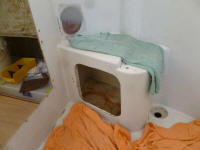
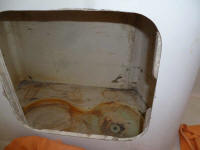 |
This led me, again from early in the project's
conception, to thoughts of reconfiguring the cockpit to
enhance its comfort and utility, at least in my eyes.
The original cockpit had featured slatted teak seats
spanning open spaces on each side, which was
functionally OK from a seating standpoint, but the
arrangement lacked storage, and I thought enclosed
lockers would be more useful. Earlier in the
project, I removed the teak seats. |
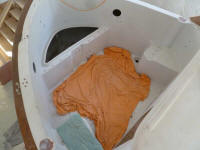 |
I supposed it was about time to begin this job, so that
I could wrap up once and for all the exterior fiberglass
work and surface prep sooner than later. I would
have preferred to continue work on the interior, but the
overall project schedule demanded I turn to the cockpit
instead. With this in mind, I began related
research into new propane tanks, the size of which would
ultimately drive the shape of things to come.
I planned to keep the propane locker in the same place,
but to convert it to top-opening and make other
improvements as needed. I wanted to use composite
tanks, and looked into various brands and sizes on the
market to figure out which direction to go. I
wanted two tanks for the convenience factor, so there'd
always be a spare.
To this end, I built two pair of tank mockups that I'd
use later in determining the overall dimensions of the
new locker (and, by direct association, the remainder of
the cockpit). For each mockup, I cut discs of 1/4"
plywood to the correct diameter, then attached wooden
legs to create the overall height. Not fancy, but
effective in visualizing the various dimensions.
One set of mockups was based on 10 lb. cylinders
available from Lite Cylinder, Seaward, and others--a
standard and typical size. The other set of
mockups emulated a squat, wide 11 lb. cylinder from
Trident Marine, which was attractive because it was a
couple inches shorter, though as large in diameter as a
stock 20 lb. cylinder.
I didn't build mockups of the standard 20 lb. cylinders.
I figured that if the width of the Trident cylinder
(same as the larger ones) worked out, then I'd see if I
could fit the large cylinders, which were only an inch
taller than the narrow 10lb. cylinders from Seaward and
Lite Cylinder. |
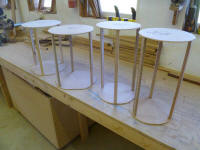
 |
I'd put these mockups to more use later in the process,
but it was one of those little constructions that was
good to get out of the way on a slow day. |
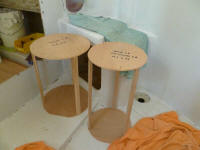 |
I also wanted to square away my steering system sooner
than later. I planned a hydraulic system,
incorporating an autopilot and other features, and
wanted to start getting a handle on what I needed. with
the notion of using one of the Vetus systems described
in the catalog, though there were other choices out
there as well.
To determine the various units needed, the catalog
described a couple calculations to determine rudder
torque and, from there, the correct helm and steering
arms. These calculations were based largely on the
size of the rudder, so I traced the rudder on some kraft
paper to make it easier to determine its true area,
incorporating the angled top and cut-off lower corner.
Then, I worked through the calculations to arrive at the
specifications for the steering gear, though this was as
far as I took the research at this point. |
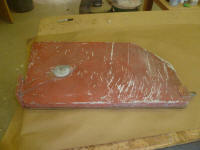
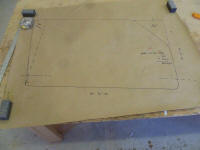 |
Finally, I applied more varnish to a few small trim
parts. |
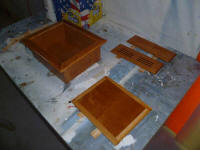
|
Total Time Today: 3 hours
|
<
Previous |
Next > |
|
|











